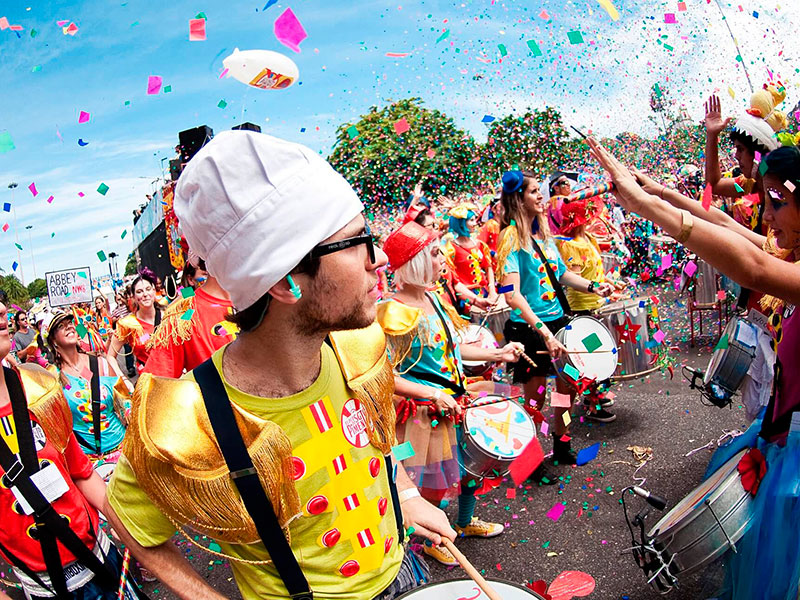
Você já comemorou o Carnaval e agora está descansando ou já está planejando o do próximo ano?
Assim como o futebol, o Carnaval brasileiro é conhecido no mundo todo, e existem muitas maneiras diferentes para ser comemorado. E se você já estiver escolhendo onde quer levar a galera ou a sua família, faça este exercício em inglês e tente descobrir quais cidades brasileiras são descritas.
E aí, qual é o seu tipo de Carnaval?
Complete the following descriptions with the given cities.
1. __________
Carnaval in _____ kicks off with an intricate masquerade ball called Baile dos Mascarados and a ceremony where the mayor gives the keys of the city to the year’s designated Carnaval King.
_____ is located in _____, which is Brazil’s most musical state and home to a rich array of Brazilian music genres like axe, pagode, and samba. Carnaval celebrations in the city of _____ traditionally include the ubiquitous use of Brazilian musical instruments like the berimbau musical bow and the atabaque drums, which provide that distinct Brazilian sound.
Visitors can observe the parades by buying access to a camarote or viewing box along the parade route. The viewing boxes are often accompanied by live music, food, and drinks as well as a great overhead view of people dancing down the streets. Another alternative is to join in the independent blocks of the city, where the street parties rage, and there is no cost to participate. Not sure where to go? Just follow the music!
2. __________
Carnaval in _____, a small colonial town in the state of _____, takes place among narrow streets full of old mansions, remnants of this small town’s rich history.
Here the party seems to never end with five days of non-stop festivities. By day, the block parties get people dancing down on the cobblestones, and at night, traditional batucada drum groups take over the streets. Tuesday’s main celebration will take place in the Old Market Square.
3. __________
In _____, the capital of the state of _____, Carnaval has varied rhythms of music, which are slightly different from the dominant genres of samba and axe. The most prominent locations of _____’s Carnaval are Iracema Beach and Avenue Domingos Olimpio, where you’ll find the majority of music and dancing.
It is also here that visitors may witness participants dressed in blackface, a tradition of the city’s maracatu to enact Afro-Brazilian characters. However, the use of blackface in this tradition has recently received some backlash and has largely been discontinued.
4. __________
Similar to _____, _____ has a competition between different samba schools during its Carnaval at the Anhembi Sambadrome, the largest outdoor event venue in _____ designed by the great Brazilian architect Oscar Niemeyer. It is here that the top samba schools congregate to compete for the grand honor of winning the Carnaval championship title.
Festival-goers in the huge metropolis of _____ can expect to see a lot of Afro-Brazilian cultural influences and dances as part of the festivities as well as daily parades through the city streets.
5. __________
A short twenty minute drive between each other, the cities of _____ offer some of the most traditional and unique Carnaval experiences Brazil has to offer.
_____ has its own distinctive Carnaval symbol: the Galo da Madrugada, or Rooster of the Dawn, and millions of revelers follow this festive and folkloric doll from the city’s historic fort to the harbor during the Saturday morning parade, while dancing frevo, _____’s regional Carnaval music.
_____’s neighbor, _____, also has carnival dancers jumping along with umbrellas to frevo beats. However, this five-day festival begins with a parade of giant puppets known as mamulengos and tends to be a smaller and more accessible celebration than the party in _____.
6. __________
Known for its seaside views and busy beach culture, _____ holds one of the best Carnaval celebrations in Brazil.
As one of Brazil’s more progressive cities, _____’ celebrations are more welcoming to LGBT partiers, particularly on Magic Island, where there is a lively street party. In the city center, you’ll find the samba schools parading on the Pasarelo do Samba. Locals and tourists of all ages are encouraged to join in!
7. __________
In the heart of the Amazon, _____’ remote location lends itself as a contributing factor of one of Brazil’s most unique Carnaval celebrations.
The creation of the “Carnaboi” party combines the celebration of Carnaval with the traditions of the indigenous peoples’ Boi Bumba festival, creating the most famous Carnaval in the Amazon. The _____ Carnaval keeps the customs of celebrations held in the early 20th century—the great parade of traditional costumes—and integrates indigenous costumes and dance customs from nearby communities.
8. __________
Host of the world’s most famous Carnaval celebration, _____ captures hearts around the world every year with its enormous parade and passionate dancers. During the event, six of the 12 best samba schools in the city march into the Sambadrome competing to be selected as the year’s champion school—but the fun doesn’t stop, or start, there.
Carnaval in _____ actually begins and ends with the individual neighborhood street parties. During this time, cariocas, an affectionate nickname for _____’s residents, take to the street to dance and sing behind decorated trucks that roam through the city blasting music. Full of creativity and humor, these parties contribute to the city’s joyful energy and are free and open for the public to attend.
8 Places to Celebrate Carnaval in Brazil
Escrito por Michel Rosas e publicado na coluna semanal de inglês da Revista Exame. Editado para o blog da Companhia de Idiomas.